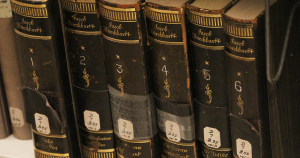
The Booth Family Center for Special Collections, which will reopen in March, will allow students to get a hands-on look at Georgetown’s rare book collection, which features books costing up to $1 million.
Students often mention how Lauinger Library, with its harsh fluorescent lighting and brash cement exterior, is the least inspirational study space. But with the planned opening in March of the Booth Family Center for Special Collections and the November addition of Ethan Henderson, a curator of rare books, that lack of inspiration may change.
Students will soon be able to hold and look through first editions of Thomas More’s “Utopia,” Euclid’s “Elements of Geometry,” John Locke’s “Two Treatises of Government” and Isaac Newton’s “Principia Mathematica.”
Georgetown University’s rare books collection will soon become more accessible to students than ever before, according to Henderson.
Most universities have special collections that are narrow in the kinds of holdings they have, but Georgetown’s collection of over 140,000 rare books defies such trends in higher education. Georgetown’s rare books range in price from $25 to nearly $1 million, according to Henderson. Not only do the books range in price, but they include a variety of topics, including math, Shakespeare, philosophy and the Modernist Age.
“I think [the collection] completely reflects Georgetown’s identity as global,” Henderson said.
The librarians and curators have struggled to make students feel welcome and aware that they have the opportunity to interact with the collection. But Henderson, who was hired by the library in the fall, hopes to change things.
“I am the biggest proponent of anybody, but students in particular, being able to touch and hold the books,” Henderson said. “That’s the whole reason why I got excited about books and people get excited about books.”
Students often feel intimidated when given the opportunity to handle fragile, rare books, a factor that may be contributing to the current low usage of Georgetown’s rare books collection, according Booth Family Center for Special Collections Director John Buchtel.
“There is a real intimidation factor but that is what the curators and librarians are for. We’re here to help and we’re here to help people, to train people on how to handle things and what to look for, how to make use of things in research,” Buchtel said.
For Buchtel, the magic lies in the fact that when students hold some of the rare books in the library’s collection, they are establishing a direct link to authors, holding the same books that some of the world’s greatest minds from Shakespeare to Newton once held. Students cannot check the rare books out of the library, but are able to read the books inside the collection’s reading room.
But students are not the only ones not often utilizing the Booth Center. The number of professors taking advantage of Georgetown’s rare books is smaller than the library would like. In the past five years, 49 faculty members from 17 departments and programs utilized the collection for their classes, according to Buchtel.
Much of the Booth Center’s collection comes from donations and only a small percentage of books have been purchased.
“A lot of [the collection] comes from alumni, people who have gone here or who have had children attend. We’ve gotten some incredible gifts from just parents,” Henderson said.
This opportunity to handle the books is a rare opportunity.
“One of the things that makes a collection really special other than just the items in it is the fact that people can access them and that students can use them. There is a point to preserving books for the sake of preserving them, but we are interested in preserving them for research,” said Jenny Smith, coordinator of Communications, Outreach and Programs.
Emily Morgan (COL ’17) said that she is excited to visit the new Booth Center once it is open in March.
“I haven’t heard of it [the Rare Books Collection] at all, but I would be interested to see what it’s about,” Morgan said. “I think it’d be really cool if professors implemented [The Rare Books collection] in some way.”
Clare Skakel (COL ’17) said that she is excited to see the collection’s access expand after it is opened.
“Well [the collection] is cool, but if nobody uses it then what’s the point?” Skakel asked.
Henderson thinks that the future for libraries will lie in their rare books collections.
“Going forward university libraries are going to look the same because everyone’s going electronic. … What’s going to make the different institutions stand out is their special collections and their holdings. So having a strong holding of rare and unique materials that reflects the institutions and reflects what Georgetown was, is, and — I may sound hokey but — will be.”














